
by Mary Caperton Morton Thursday, June 15, 2017
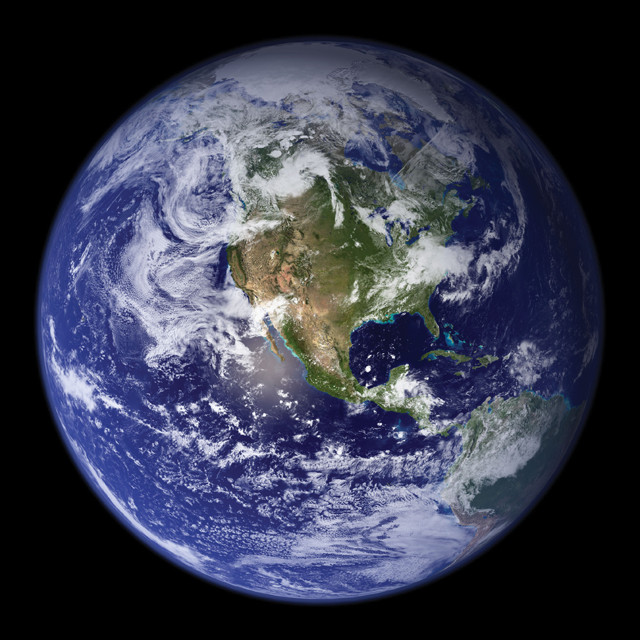
Credit: NASA.
Earth is the only planet known to have active plate tectonics, and also the only place that hosts life. Could that be a coincidence? It’s possible, but most geoscientists don’t think so. In many ways, it seems plate tectonics was fundamental in setting the stage for biological evolution and for maintaining and sustaining life on Earth.
“A planet with oceans, continents and plate tectonics maximizes opportunities for speciation and natural selection, whereas a similar planet without plate tectonics provides fewer such opportunities,” wrote Bob Stern, a geologist at the University of Texas at Dallas in Geoscience Frontiers in late 2015. “Plate tectonic processes such as the redistribution of continents, growth of mountain ranges, formation of land bridges, and opening and closing of oceans provide a continuous but moderate environmental pressure that stimulates populations to adapt and evolve.”
But exactly when plate tectonics began operating on Earth, and when life evolved, are open questions. There is no widespread consensus on an answer to either. In a poll taken last summer at a plate tectonics conference at ETH Zurich in Switzerland, 45 out of 65 participants agreed that plate tectonics likely began about 3 billion years ago, during the Archean. But the remaining 20 participants held varying opinions, with some advocating for some form of plate tectonics as early as 4.2 billion years ago, and others, including Stern, suggesting the process began much later, about 1 billion years ago.
Similarly, it is unknown when life first evolved on Earth. The earliest microfossils date to 3.5 billion years ago, but these appear to be complex enough to suggest that they likely had many generations of predecessors. Rocks older than 3.5 billion years are usually too metamorphosed to preserve fossils. But geochemical evidence from 3.8-billion-year-old banded iron formations in West Greenland, and 4.1-billion-year-old zircon crystals found in Australia — finds first reported in Nature in 1996 and in Proceedings of the National Academy of Sciences in 2015, respectively — hint that biological activity may have been altering isotopic ratios of carbon much earlier.
Last month, in the first part of this two-part feature on plate tectonics, we explored the onset of plate tectonics on Earth, looking at the initial conditions that gave rise to Earth’s patchwork of plates; when active plate tectonics with subduction zones, deep mantle recycling and spreading ridges might have started; and what forces have sustained this planet-wide process over billions of years. This month, we investigate links between plate tectonics and the evolution of life on Earth. What is water’s role in both plate tectonics and life? What can other planets or moons teach us about our own planet? And if we find plate tectonics on another planet, might we also find water — or even life?
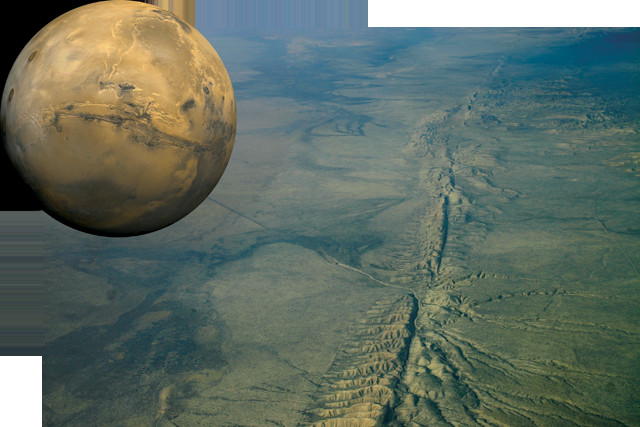
Mars shares certain tectonic features in common with Earth, such as the 4,000-kilometer-long Valles Marineris canyon system (above) — the longest and deepest canyon system in the solar system — which scientists suggest may have been created by a massive strike-slip fault system, similar in scale to the San Andreas Fault in California (right). Displacement along both faults is about 150 kilometers, but while the San Andreas took just 3 million years to move that much, the Valles Marineris fault took more than 3 billion years. Credit: above: NASA; right: Lkluft, CC BY-SA 1.0.
Plate tectonics comprises the shifting puzzle of interconnected slabs of crust and uppermost mantle (together called the lithosphere) that collide and diverge, generating earthquakes, fueling volcanoes, opening ocean basins and raising mountain ranges. Plate tectonics involves a recycling system for the crust through subduction, in which one plate dives beneath another and is reincorporated into the mantle. This crustal destruction is balanced by the generation of new crust through volcanism.
“We know from the rest of the solar system that plate tectonics is a very rare animal,” says Chris Hawkesworth, a geochemist at the University of Bristol in England. Earth is the only planet known to feature active plate tectonics. The three other rocky planets in the inner solar system — Mercury, Venus and Mars — as well as our moon all show some evidence of past periods of geologic unrest in the form of resurfacing, mountain building and volcanism, but none exhibit signs of global plate tectonics.
The other rocky planets in our solar system offer a glimpse of what early Earth may have looked like before plate tectonics. “Most of the other planets in the solar system stopped being [geologically] active a long time ago, and the ones that are still active are moving very slowly,” says An Yin, a geophysicist at UCLA. This slow to nonexistent pace gives geologists opportunities to study how primitive tectonics worked in the early days of the solar system, he says. With Earth, “it’s like we’re only seeing the ending of a very fast-paced movie and we can’t reconstruct what happened in the beginning.”
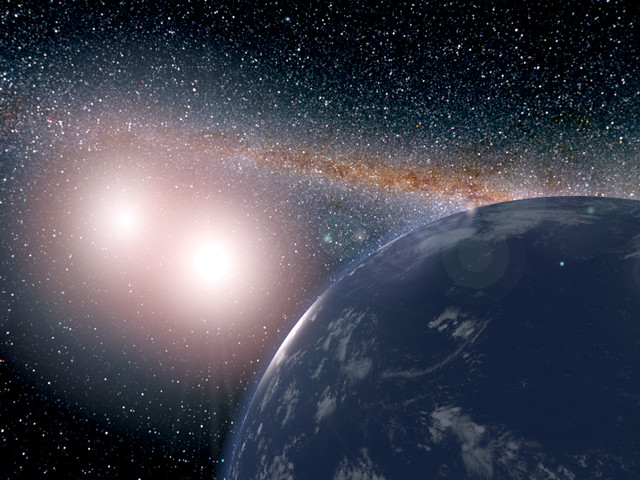
Artist's conception of a hypothetical exoplanet covered in water around the binary star system of Kepler-35A and B. Could exoplanets with similarities to Earth host life? Credit: NASA/JPL-Caltech.
Mars, on the other hand, “is playing the role of an evolving rocky planet at a much more comprehensible pace,” Yin says. It shares certain tectonic features in common with Earth, such as the 4,000-kilometer-long Valles Marineris canyon system — the longest and deepest canyon system in the solar system — which Yin and his colleagues suggested in 2012 was created by a massive strike-slip fault system, similar in scale to the San Andreas Fault in California. Displacement along both faults has totaled about 150 kilometers, but while the San Andreas took just 3 million years to move that much, the Valles Marineris fault took more than 3 billion years, the team reported in Lithosphere. Still, overall, tectonics on Mars are simpler and far more localized than on Earth, and are not indicative of a full-fledged plate tectonic system.
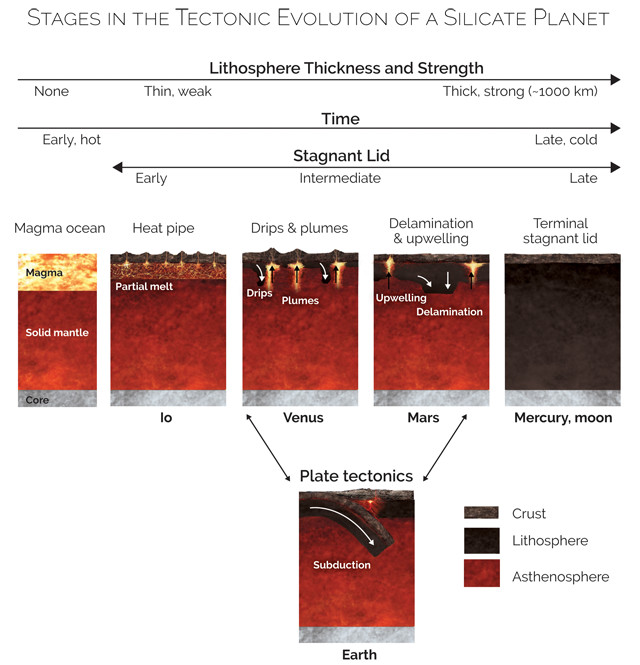
Mars, Venus, Mercury and the moon feature variations on the stagnant lid system, in which the planet's entire lithosphere exists as a single unbroken plate. Some scientists think that Venus' stagnant lid most closely resembles the pretectonic regime of early Earth. Credit: K. Cantner, AGI, after Stern, Geoscience Frontiers, December 2015.
Mars, Venus and Mercury are governed by what geologists call stagnant-lid tectonics, where the planet’s entire lithosphere exists as a single globe-encircling plate — as opposed to an interconnected system of moving tectonic plates. But stagnant-lid regimes have a “tremendously wide range of manifestations,” Stern says, perhaps reflecting the many possible stages of mantle evolution that Earth might have undergone before modern plate tectonics began. “The moon has a stagnant lid but it’s deader than a doornail,” he says. “Venus has a very active stagnant lid and Mars has a sluggish stagnant lid. They all have signs of igneous activity and deformation, but none have plate tectonics.”
Of the three innermost rocky bodies in the solar system, Venus is perhaps the closest analogue to early Earth, says Taras Gerya, a geodynamicist at ETH Zurich. “Venus has a lid, which is not broken into a mosaic of plates, but does show some internal deformation,” Gerya says. Venus also shows evidence of having experienced vigorous resurfacing in the past, which may have been driven by mantle plumes or even some form of subduction. “It’s not strictly a stagnant lid. Perhaps it’s more of a squishy lid, with the plumes stretching and deforming the lithosphere.”
“The most important difference between stagnant-lid [systems] and plate tectonics is that plate tectonics provides a mechanism for two-way transport of materials between the deep mantle and the surface,” says Jun Korenaga, a geophysicist at Yale University. Material can make its way to the surface, and can also be recycled back into the system, he says. “This has a huge impact on the carbon cycle, with the atmospheric concentration of carbon dioxide regulated by plate tectonics over long timescales.” Sequestering or recycling carbon is essential for preventing runaway greenhouse warming that could make the surface of a planet uninhabitable over geologic timescales.
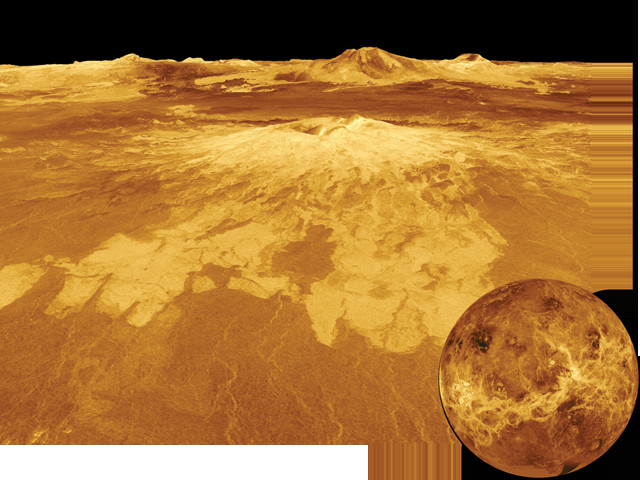
Although Venus' surface is not broken into plates, it does show internal deformation, including active volcanoes. Venus also shows evidence of having experienced vigorous resurfacing in the past, which may have been driven by mantle plumes or even some form of subduction. Credit: both: NASA/JPL.
Plate tectonics also cools the mantle to some degree, Korenaga says. “A stagnant-lid regime is like keeping a lid on hot soup. There’s nowhere for the heat to go,” he says, much of the time at least. Venus is thought to have undergone a complete resurfacing of its crust about 600 million years ago, presumably after mantle temperatures reached a critical level and caused planetwide volcanism.
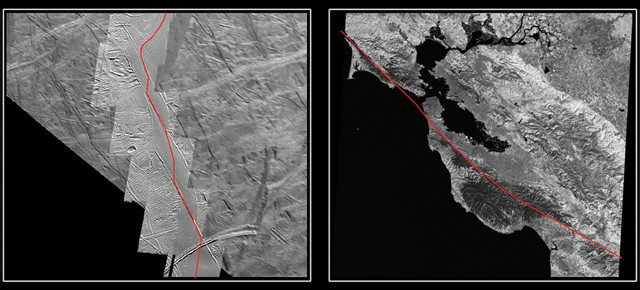
The Astypalaea Linea Fault on Europa (left) is similar to the San Andreas Fault on Earth (right), and may indicate active deformation. Credit: both: NASA-JPL/University of Arizona.
“With plate tectonics, old, cold slabs subducting into the mantle have an effect like dumping ice cubes in hot water,” Korenaga says. Convective cooling of the mantle helps drive the geodynamism of Earth’s core, which in turn helps generate the planet’s geomagnetic field. “You need to have a strong geomagnetic field to maintain an atmosphere and surface water over geologic timescales,” he says. “Without it, intense solar winds can easily scrape off a planet’s atmosphere,” which is what happened long ago to Earth’s moon and to Mars after their geodynamos shut down.
Beyond the inner planets, there’s some evidence for limited tectonics on the rocky and icy moons of Saturn and Jupiter. Saturn’s moon Enceladus, for example, may show signs of localized strike-slip faulting, and Jupiter’s moon Europa is covered with massive slabs of ice that may move over and under each other, but observing these places from afar with sufficient clarity to make out the details of any tectonic activity is not easy. Researchers also wonder about the possibility of plate tectonics on rocky exoplanets, though those are even harder to observe, of course. So far, “all of the arguments for or against tectonics on other planets and moons [have proved] difficult to pin down,” Hawkesworth says. “It’s hard to know what the evidence is for plate tectonics on a planet you can’t access. We have a hard enough time studying plate tectonics on our own planet.”
One thing researchers know for sure is that abundant liquid water is a necessary ingredient for both life and plate tectonics as we know them on Earth. Without water, it’s unlikely a planet could develop plate tectonics, says Jeroen van Hunen, a geophysicist at Durham University in England. “Water reduces the strength of rocks — hydrous minerals are always weaker than dry minerals — and lowers the melting temperature of rocks by hundreds of degrees,” he says. On Earth, water was needed to break the planet’s lithosphere into tectonic plates and for those plates to begin sliding over, under and past one another.
Zircon crystals from the Hadean Eon suggest that water could be found on Earth as early as 4.4 billion years ago. Where this water came from and how much existed on early Earth is largely unknown. At first, water would have only been present as water vapor, until about 3.8 billion years ago, when surface temperatures cooled below water’s boiling point, allowing liquid water to begin accumulating at the surface. Continued degassing of Earth’s interior, along with melting of hydrous minerals, would have brought water vapor up to the surface, where it could condense into rain that would have fallen onto the young planet’s rocky surface, eventually filling up vast ocean basins by about 3 billion years ago — coincidentally, or not, about the same time when many people think plate tectonics started.
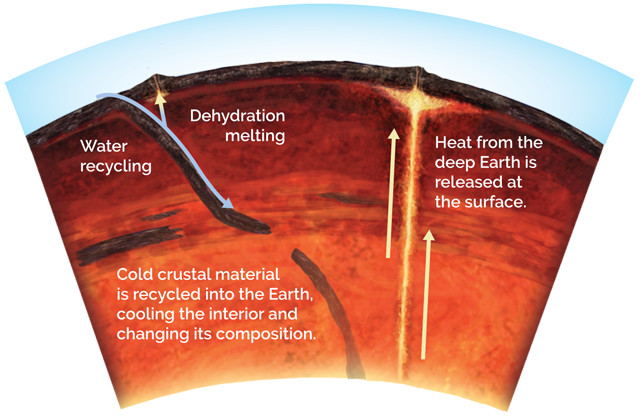
As subducting oceanic plates descend into the mantle, they carry huge quantities of water with them, replenishing the mantle and fueling dehydration melting. Credit: K. Cantner, AGI.
Earth’s mantle has been degassing for billions of years and yet the planet’s interior still contains massive amounts of water. Water in the mantle is found in both nominally anhydrous minerals, such as olivine (in which water squeezes into the mineral’s crystal structure at high pressures at depth), and hydrous minerals such as mica, amphibole, serpentine and wadsleyite (in which water is part of the mineral’s chemical structure). How much water the young mantle contained is one of the major unknowns in modeling scenarios of early tectonics, says Bruno Dhuime, a geochemist at the University of Bristol. “Modeling how the plates might have moved on the hotter early Earth depends a lot on to what extent water was present in the mantle,” Dhuime says. “If the water content was similar to what it is today, the flow of the mantle [would] allow for plate tectonics. But if the mantle was a lot drier, it [would have been] very difficult to get plate tectonics to operate.”
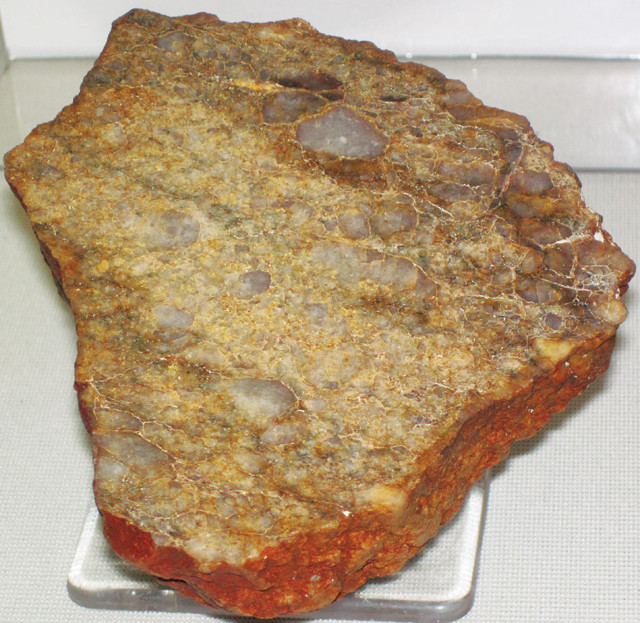
This quartz-pebble metaconglomerate from the Jack Hills Formation in Australia contains zircon crystals that are between 3.05 billion and 4.4 billion years old. Such zircons suggest that water could be found on Earth as early as 4.4 billion years ago. Credit: James St. John, CC BY 2.0.
Scientists also think that plate tectonics is necessary for maintaining Earth’s balance of surface and interior water. As subducting oceanic plates descend into the mantle, they carry huge quantities of water with them, replenishing the mantle and fueling dehydration melting, van Hunen says. Without the recycling effect of plate tectonics, the billions of years of degassing of water vapor from the mantle would have depleted the planet’s interior stores, he says.
In a 2014 study in Science, Brandon Schmandt, of the University of New Mexico, and colleagues used seismologic observations and geodynamic modeling to show that the upper mantle acts as a massive reservoir for water, with much of it collecting around the transition zone between the upper and lower mantle, between 410 and 660 kilometers below Earth’s surface. Thus, the planet’s hydrologic cycle involves not just the atmosphere, oceans and surface waters, but also the planet’s interior, which is coupled to the surface by plate tectonics. This hydrologic balancing act, unique to Earth as far as we know, may help explain why other planets don’t have abundant liquid surface water or plate tectonics.
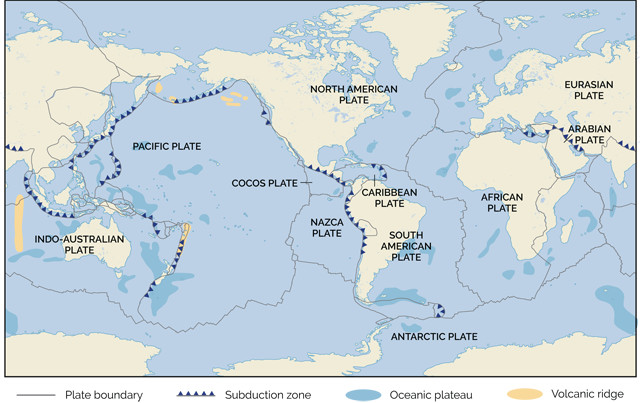
Earth has eight major and dozens of minor plates, each of which is composed of crust and upper mantle. Credit: K. Cantner, AGI.
By seeding the oceans, creating an atmosphere, balancing climate feedback cycles and creating geographical pathways for biological evolution, plate tectonics helped set the stage for the evolution of life — especially complex life.
“Aqueous environments were essential for the simple, single-celled organisms that existed early in Earth history,” Stern wrote in his 2015 Geoscience Frontiers paper. In water, a cell “needs only a weak container (cell wall), the cell cannot desiccate, and nutrients are readily absorbed through a semi-permeable cell wall.” And plate tectonics was likely instrumental in creating a surface environment that could support large bodies of water.
Even if life appeared millions, or even billions, of years before plate tectonics, the link between the two isn’t lost, Stern says. Plate tectonics isn’t “necessarily linked to the origins of life, but rather to the evolution of higher life: Multicellular animals start appearing in the Neoproterozoic, about 1 billion years ago,” he says, which is when he thinks modern-style plate tectonics got started. “Evolution is driven by the isolation of species as well as competition between species for similar niches.”
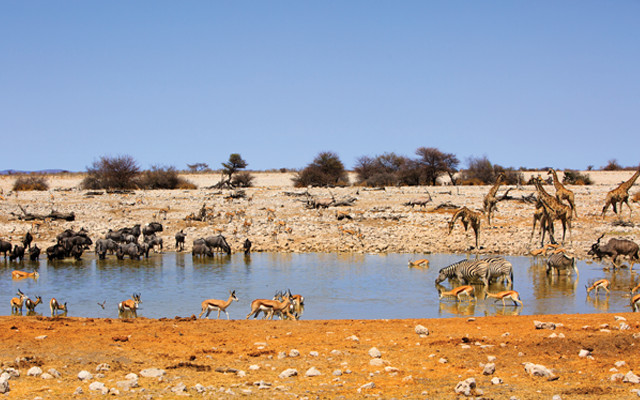
The diversity and complexity of life on Earth owe their existence to plate tectonics. Credit: iStockphoto.com/paulafrench.
When continents break up and ocean basins are separated, species are isolated, and when continents come together and ocean basins open up, species are forced to compete, adapt and evolve. “Plate tectonics isolates and reconnects landmasses, separates and reconnects oceans, builds mountain ranges and makes new shallow marine environments on continental shelves,” Stern wrote.
Tectonic processes may also have paved the way for additional higher life forms by killing some of them off occasionally, Gerya says. “Advanced life needs stressors to promote development and natural selection,” he says. Such stressors can include extinction events wrought by geologic upheavals.
Extinction events generally have three origins: biologic, exogenic and endogenic.
Biologic extinctions occur when some organisms exert pressure on other organisms, either by predation or competition. “Biological pressures can partly reflect plate tectonic causes, for example by producing land bridges or oceanic gateways that allow predators, competitors, parasites, etc., access to a vulnerable species,” Stern wrote. Exogenic extinctions originate in space in the form of cosmic radiation or meteorite impacts, such as the collision that helped finish off the dinosaurs and opened new ecological niches that allowed mammals to diversify. Endogenic extinctions are caused by Earth-based geologic processes, such as massive bouts of flood volcanism. The Siberian Traps, for example, once covered much of Siberia with thick layers of basalt and released huge stores of volcanic gases, killing off up to 81 percent of marine life at the end of the Permian.
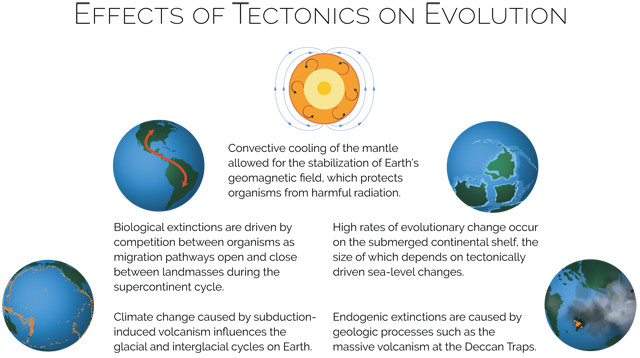
Credit: K. Cantner, AGI.
Plate tectonics may also drive evolution by affecting climate through volcanism. Subduction zones fuel explosive eruptions at volcanoes formed on the overriding plate, such as those found around the Pacific Ring of Fire. “These volcanoes inject both sulfur dioxide and carbon dioxide into the atmosphere, which affect climate in different ways on different timescales,” Stern says. Sulfur dioxide tends to act as cooling agent on shorter timescales, while carbon dioxide is a warming agent that accumulates over longer timescales. “These competing influences would have been jumpstarted at the beginning of plate tectonics,” he says.
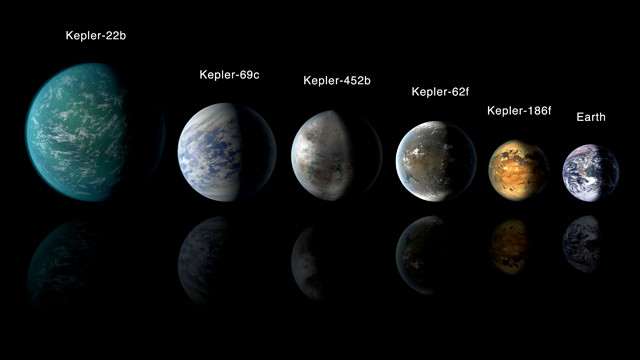
These exoplanets with similarities to Earth exist within the habitable zones of their stars. Credit: NASA/Ames/JPL-Caltech.
At times, these feedback cycles may have conspired to plunge Earth into deep ice ages. Some of these glacial periods (also known as “snowball Earth” periods) may be linked to the onset of plate tectonics, Stern says, including the Huronian glaciation dating to 2.4 billion years ago, the Sturtian glaciation about 750 million years ago and the Marinoan glaciation about 650 million years ago. “Most models rely on excess weathering or other explanations [to explain] the climatic crisis of the Neoproterozoic. One driver that [modelers] haven’t always considered is the beginning of plate tectonics,” he says.
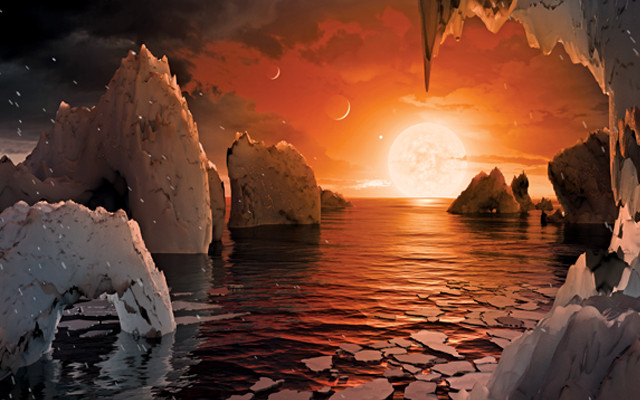
Artist's conception of the surface of exoplanet TRAPPIST-1f, one of seven newly discovered planets orbiting TRAPPIST-1, an ultra-cool dwarf star about 40 light-years away from Earth. Three of the planets are in the habitable zone around the star. Credit: NASA/JPL-Caltech.
That Earth lays claim to being the only known planet with both plate tectonics and complex life is no coincidence: These two features are inextricably linked. The most obvious connection is water, but a host of other characteristics also conspired to transform the fiery hot early Earth into a veritable oasis, able to support life for billions of years. Other planets in our solar system offer glimpses of what might have been if Earth had proved too hot, or too cold, to host the liquid water needed to kick-start plate tectonics and sprout the first seeds of life.
Elsewhere, in the far reaches of the universe, there may be another planet that supports life. After all, we’ve already found thousands of rocky planets and experts think there may be millions and perhaps billions more out there. Do any of them have active plate tectonics, water or, perhaps, even life? Only exploration will tell.
© 2008-2021. All rights reserved. Any copying, redistribution or retransmission of any of the contents of this service without the expressed written permission of the American Geosciences Institute is expressly prohibited. Click here for all copyright requests.